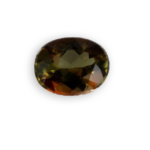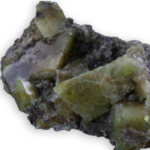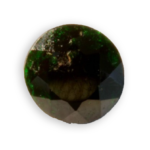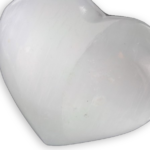
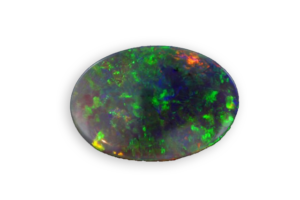
opal
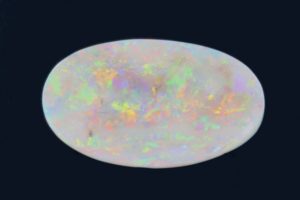
rough withe opla from Coober Peddy in Australia
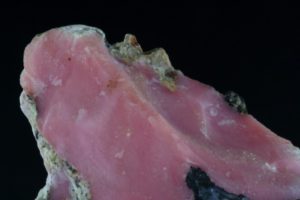
rough pink opal from Perou
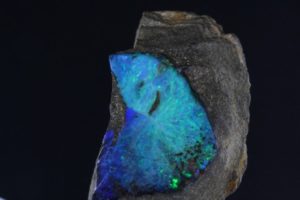
rough Australian opal
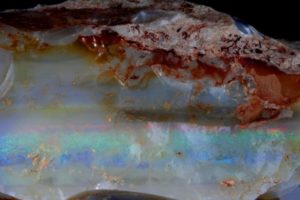
white opal from Cober-Peddy in Australia
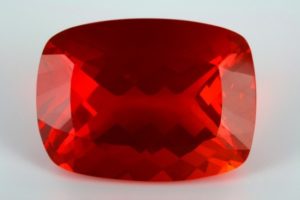
fire opal cushion cut from Mexico
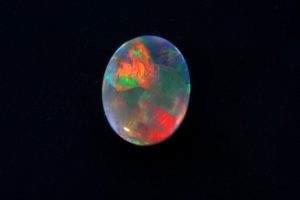
harlequin opal cabochno from Australia
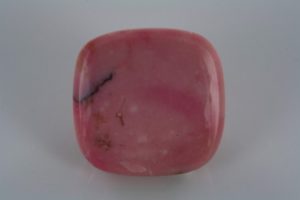
pink quinzite opal cabochon from France
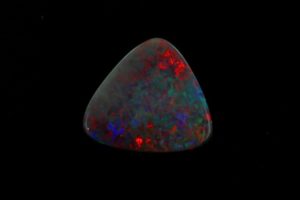
red opal cabochon from Australia
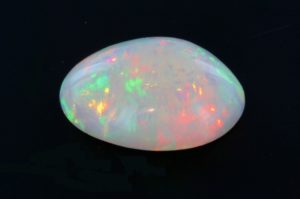
inclusions in opal from Ethiopia
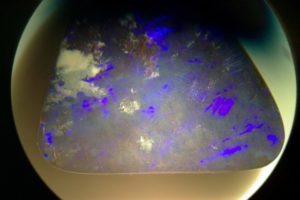
color – type inclusion with diffraction interference in a boulder opal
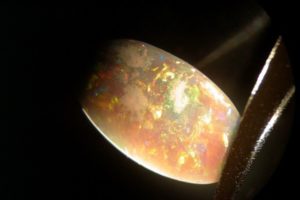
solid inclusions in precious opal from Australia
Detailed sheet
opal
Its name comes from the Sanskrit “upala” which means precious stone, or the Greek “opallios” and Latin “opalos”. It is distinguished by iridescent reflections depending on the angle of vision, recalling the rainbow, who gave the term “opalescent”. Hydrated silica gel, it does not crystallize.
Pliny the Elder discusses the opal, and it was through his writings that the Latinized name of this stone “opalus” has reached us.
In 1075, the Bishop of Rennes confers it special powers and, thinking that its owner could become invisible, called it the “stone of thieves”.
King Louis XI would cut off the hands of a lapidary who would have broken a beautiful stone that he had entrusted.
It must be said that being very fragile and to be cut with extreme caution, this stone often breaks during its preparation.
Today, in the Anglo-Saxon countries, it remains the stone symbolizing engagement.
The heroine of the novel by Walter Scott, Anne of Geierstein, who lived terrible adventures, wore an opal and, after having thrown it overboard, her life became again peaceful. A rumor grew, spread in France by the Empress Eugenie, who had been impressed by reading the novel, claiming that it was an evil stone. It was banned at the court of the czars. The diamond cutters of that time propagated this idea, probably because they feared that their clients refused to pay them if they broke the stone during the work.
It was Queen Victoria that wearing an opal from Australia at his coronation assured the promotion of the opal from Australia throughout the Commonwealth. Currently, outstanding creations have given to the opal its rightful place in jewelry.
The colors are extremely variable, green, pink, bright orange (fire opals), going towards the “harlequin” with a beautiful iridescence. The quincite is a pink opal discovered in Quincy-sur-Cher close to Bourges in central France, its pink color is due to natural pigments made by some algae during the formation of opal.
The cacholong is a white opal called porcelanique because it has the appearance of a porcelain, the variety used in jewelry comes mainly from a region near the river Kashgar in Chinese Xinjiang. Its composition is between the opal and chalcedony or jasper, and its specificity is that it is very porous. The surface layer of a white flint consists of cacholong and the presence of this layer means that the flint or chalcedony has long been exposed to the elements allowing the formation of this layer of cacholon and it is an indicator of its age.

CHEMICAL CHARACTERISTICS
SiO2 nH2O
hidrated silica

PHYSICAL CHARACTERISTICS
Main color
white
Other colors
blue, brown, grey, yellow, black, orange, pink, red, green, purple
all the existing colors are available in many different shades
Color of streak
white
Luster
vitreous
Hardness
5.5 to 6.5
Density
2.00 to 2.20
Cleavage
none
Fracture
conchoidal, splintery

OPTICAL PROPERTIES
Transparency
translucent, transparent
Refractive index
1.430 - 1.450
Double refraction
0.000
none
visible double refraction
No
Dispersion
-
Pleochroism
absent
Number of colors
1
Absorption spectrum
700 - 640 - 590 - 400
spectrum of the fire opal

fire opal spectrum system
Fluorescence
variable
white, blue, brown, green

CRYSTALS PROPERTIES
silica beads in a silica gel

OTHER INFORMATIONS
Astrological sign
Aquarius, Cancer, Gemini, Libra, Pisces, Taurus
Month
october
Chinese astrological sign
Snake

APPROACHING GEMS
Exploited
sites
For thousands of years, the opals were collected near Cervenitsa in the valley of the Vah (Dubnik region, now Slovakia), but the deposits are exhausted. Now we can include the United States (Idaho, Nevada , California, Oregon, Alaska, Brazil, Honduras, Mexico (where the Aztecs exploited it and showed it at Cortez), Ethiopia, Guatemala, Indonesia, Japan, Russia, Peru and … France with its deposits of the Alpes-Maritimes (Biot) and Quincy, near Mehun-sur-Yevre (Cher).
Australia has the major deposits (in New South Wales: Lightning Ridge, White Cliffs, Victoria, Queensland, in South Australia: Coober Peddy, Andamooka).
The characteristic of these Australian deposits is that they are of sedimentary origin (as in Brasil) when the other deposits have volcanic origin.
Since the 70’s: the discovery of Peruvian opals, which is also called opal of the the Andes, it is blue, green, yellow, pink, translucent or opaque and without iridescence, it is cut faceted or cabochon.
Today in Ethiopia, in the Wollo region, some transparent, translucent opals, with lights of all colors, are found.
The cacholong comes principally from the chinese region of Xinjang, but also from Uzbekistan, Mongolia, Iceland, Italy, Austria, France in the Var, Austria, Czech Republic in Moravia …
use in jewelry
The cut of the opal is very delicate.
The fire opal is cut in cabochons or faceted, some have lights.
Only precious opals are used in jewelry and specialists distinguish a range of variants:
The common opals : many colors but without lights.
The precious opals: precious opal or Harlequin (formerly Eastern), with all sorts of colors and lights, the most popular are the red lights.
The hydrophane opal that is opaque and becomes transparent when it absorbs water, white opal, black opal, matrix (with veins of the host rock), water opal (or hyaline, transparent opalescent), gyration: which is often cloudy and milky. There are also opals containing inclusions, such as dendritic opal, the foam opal …
The cacholong being a very porous material that absorbs all the liquid is often treated to prevent it from becoming stained.
Opal is the anniversary stone for the 14th year of marriage.
Daily care
and precautions
This is one of the most fragile gems: it is sensitive to shocks, cosmetics, soaps, household cleaning products and should be avoided to wear while manipulating them, or even while washing hands. When mounted on a ring, avoid clashes, scratches. It maintains by submerging it in water as often as possible. It could also remain continuously in the water! Without moisture, the opal eventually would “die”, that is to say, losing its opalescence, its lights, crack. It gets easily mat. The opal, containing 3 to 30% of water, dehydrates, and could break if it is kept in very dry air, hence the need to keep it away from heat in a humid atmosphere. Gemologists carefully don’t want to measure its refractive index, because of the aggressiveness of the optical liquid. Attention also should be paid to the warm lights in the jewelers windows.
imitations and
treatments
Although the imitation is very difficult, having the opal a source of fixed color in the background and one from the reflection of light, we still managed to imitate it. In the XVIII century, colored glass was used, in a pale blue to milky appearance that was backed by a dyed silk . They were also used butterflies wings, hummingbird feathers, peacock and also glass or resin. It also imitates by inserting a layer between a pearl opalescent glass in a dome or in a resin.
The milky opal is reproduced by embedding showy variously colored in an opalescent glass. The cutting of a thin section of the nacre of some Australian shell, polished and silver filled and cemented on quartz or glass produces an excellent effect.
The fire opal can be imitated by using a kind of bakelite, which gives the appearance of a waving flame surface but it is much less dense. It is difficult to use heavy liquid of a same refractive index to detect fake stones, as natural opal is too porous.
Opal doublets were created with a very thin opal glued on a common opal or onyx or black cement, giving the illusion of a black opal.
Triplets add an extra layer, above, of rock crystal, chalcedony or translucent plastic of very low quality. These fraudulent creations should be reported without ambiguity.
Synthetic opal is produced since the seventies.
improvements
Opals fearing dehydration should be regularly immersed in water.
Historical
healing properties
Many healers assign specific properties to each variety of opal. Thus, common opal would have calming effects, soothing, stimulating thinking and promoting sleep while fire opal would regulate menstrual periods, would help facilitate procreation and female births, especially suiting the Sex chakra giving less inhibitions, increasing desire … The power of opal it is credited with promoting sleep, dreams, love. This is the stone of love, purity of feelings, of loyalty and mutual trust.
The black opal eliminates th fear of the dark. Because of its iridescence, the opal is a link between us and the various “colors” of life. Orientals attributed to it the meeting of the virtues of all other stones, what the physician and naturalist Boethius Boodt confirms in the seventeenth century.
Symbol of tender love, trust, purity, it would be an initiation to the potential light all natural phenomena and could raise our perception at the level of those of cosmic origin, to the white light which divides into seven colors that combine to give all the others. The dominant colors indicate the chakras to whom they correspond to. The Opal could also make us aware of our desires, our needs, our weaknesses and blockages, but it also would trigger in our heart a feeling of joy and satisfaction.
The fire opal appears to play a special role in reactivating our feelings and clarifying our understanding.
It corresponds to Pisces, Cancer (the very clear opal ), Sagittarius, Aquarius, Scorpio (the black opal), Aries (fire Opal).
historical stones
and related legends
The famous opals: the biggest in the world, said the Hungarian, weighed 2410 carats. One of the most beautiful and also very big, still preserved at the Natural History Museum of Vienna, was discovered in a creek bed in Dubnik in 1775, it weighs over 600 grams ( 21 ounces ), measuring 12 by 5,7 cm. ( 4.7 by 2.24 inches ). The Natural History Museum in New York exhibits one of the largest Australian Opal (50 x 15 cm) and the Smithsonian Institute in Washington owns one weighing 155 carats.
The British Treasury has one of two fragments from the fracture of an opal discovered in the late nineteenth century in Queensland, it weighs 250 carats and reflects iridescent red, purple and green. The Museum of Budapest has the most comprehensive collection of opals from Dubnik: 366.926 samples, weighing a total of 58,645 carats!
The National Museum of Natural History in Paris retains an opal which is part of the crown jewels that once belonged to Louis XVIII. Two stones of great value, the Orphanus adorning the crown of the Holy Roman Empire and the Fire trojan (yet said Fire of Troy) of the empress Josephine have disappeared. An ancient legend says that at the dawn of humanity, on a continent far, far beyond the seas, a rainbow dropped a god from the sky, the people who lived there recognized him as the creator of dream times. One day, without warning and without apparent reason, he left. The rainbow disappeared also, but where it touched down, the rocks turned into multicolored gems. This far continent became Australia.
The multi colored gemstone was named iridescent opal. In the Middle Ages, people believed that the thieves who carried one wrapped in a laurel leaf became invisible. In ancient Rome, where it is considered a lucky charm, a senator, named Nonius, chosethe exile in Egypt where he died in poverty, while retaining its stone, rather than giving away an opal of the extraordinary size of a walnut that Mark Antony wanted to take from him to offer to Cleopatra.
Venez visitez
notre site web
voillot-joaillier.fr
Lorem ipsum dolor sit amet, consectetur adipiscing elit. Ut elit tellus, luctus nec ullamcorper mattis, pulvinar dapibus leo.Lorem ipsum dolor sit amet, consectetur adipiscing elit. Ut elit tellus, luctus nec ullamcorper mattis, pulvinar dapibus leo consectetur adipiscing elit. Ut elit tellus, luctus nec.

